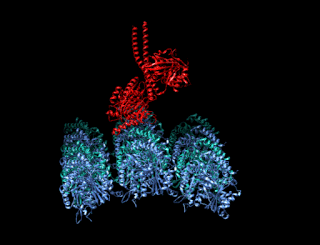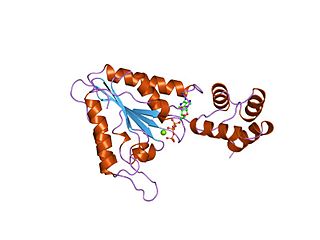
Carbamoyl phosphate is an anion of biochemical significance. In land-dwelling animals, it is an intermediary metabolite in nitrogen disposal through the urea cycle and the synthesis of pyrimidines. Its enzymatic counterpart, carbamoyl phosphate synthetase I, interacts with a class of molecules called sirtuins, NAD dependent protein deacetylases, and ATP to form carbamoyl phosphate. CP then enters the urea cycle in which it reacts with ornithine to form citrulline.

A kinesin is a protein belonging to a class of motor proteins found in eukaryotic cells. Kinesins move along microtubule (MT) filaments and are powered by the hydrolysis of adenosine triphosphate (ATP). The active movement of kinesins supports several cellular functions including mitosis, meiosis and transport of cellular cargo, such as in axonal transport, and intraflagellar transport. Most kinesins walk towards the plus end of a microtubule, which, in most cells, entails transporting cargo such as protein and membrane components from the center of the cell towards the periphery. This form of transport is known as anterograde transport. In contrast, dyneins are motor proteins that move toward the minus end of a microtubule in retrograde transport.

Dyneins are a family of cytoskeletal motor proteins that move along microtubules in cells. They convert the chemical energy stored in ATP to mechanical work. Dynein transports various cellular cargos, provides forces and displacements important in mitosis, and drives the beat of eukaryotic cilia and flagella. All of these functions rely on dynein's ability to move towards the minus-end of the microtubules, known as retrograde transport; thus, they are called "minus-end directed motors". In contrast, most kinesin motor proteins move toward the microtubules' plus-end, in what is called anterograde transport.

AAA proteins or ATPases Associated with diverse cellular Activities are a protein family sharing a common conserved module of approximately 230 amino acid residues. This is a large, functionally diverse protein family belonging to the AAA+ protein superfamily of ring-shaped P-loop NTPases, which exert their activity through the energy-dependent remodeling or translocation of macromolecules.
Katanin is a microtubule-severing AAA protein. It is named after the Japanese sword called a katana. Katanin is a heterodimeric protein first discovered in sea urchins. It contains a 60 kDa ATPase subunit, encoded by KATNA1, which functions to sever microtubules. This subunit requires ATP and the presence of microtubules for activation. The second 80 kDA subunit, encoded by KATNB1, regulates the activity of the ATPase and localizes the protein to centrosomes. Electron microscopy shows that katanin forms 14–16 nm rings in its active oligomerized state on the walls of microtubules.
Dynein ATPase (EC 3.6.4.2, dynein adenosine 5'-triphosphatase) is an enzyme with systematic name ATP phosphohydrolase (tubulin-translocating). This enzyme catalyses the following chemical reaction
Plus-end-directed kinesin ATPase (EC 3.6.4.4, kinesin) is an enzyme with systematic name kinesin ATP phosphohydrolase (plus-end-directed). This enzyme catalyses the following chemical reaction
Minus-end-directed kinesin ATPase (EC 3.6.4.5) is an enzyme with systematic name kinesin ATP phosphohydrolase (minus-end-directed). This enzyme catalyses the following chemical reaction
Translocase is a general term for a protein that assists in moving another molecule, usually across a cell membrane. These enzymes catalyze the movement of ions or molecules across membranes or their separation within membranes. The reaction is designated as a transfer from “side 1” to “side 2” because the designations “in” and “out”, which had previously been used, can be ambiguous. Translocases are the most common secretion system in Gram positive bacteria.
In enzymology, an alpha-factor-transporting ATPase (EC 3.6.3.48) is an enzyme that catalyzes the chemical reaction
In enzymology, a K+-transporting ATPase (EC 3.6.3.12) is an enzyme that catalyzes the chemical reaction
In enzymology, a maltose-transporting ATPase (EC 3.6.3.19) is an enzyme that catalyzes the chemical reaction
In enzymology, a nitrate-transporting ATPase (EC 3.6.3.26) is an enzyme that catalyzes the chemical reaction
In enzymology, a peroxisome-assembly ATPase (EC 3.6.4.7) is an enzyme that catalyzes the chemical reaction
In enzymology, a phosphate-transporting ATPase (EC 3.6.3.27) is an enzyme that catalyzes the chemical reaction
In enzymology, a phospholipid-translocating ATPase (EC 3.6.3.1) is an enzyme that catalyzes the chemical reaction
In enzymology, a proteasome ATPase (EC 3.6.4.8) is an enzyme that catalyzes the chemical reaction

Katanin p80 WD40-containing subunit B1 is a protein that in humans is encoded by the KATNB1 gene.

Katanin p60 ATPase-containing subunit A1 is an enzyme that in humans is encoded by the KATNA1 gene.

Ronald David Vale ForMemRS is an American biochemist and cell biologist. He is a professor at the Department of Cellular and Molecular Pharmacology, University of California, San Francisco. His research is focused on motor proteins, particularly kinesin and dynein. He was awarded the Canada Gairdner International Award for Biomedical Research in 2019, the Shaw Prize in Life Science and Medicine in 2017 together with Ian Gibbons, and the Albert Lasker Award for Basic Medical Research in 2012 alongside Michael Sheetz and James Spudich. He is a fellow of the American Academy of Arts and Sciences and a member of the National Academy of Sciences. He was the president of the American Society for Cell Biology in 2012. He has also been an investigator at the Howard Hughes Medical Institute since 1995. In 2019, Vale was named executive director of the Janelia Research Campus and a vice president of HHMI, his appointment began in early 2020.







